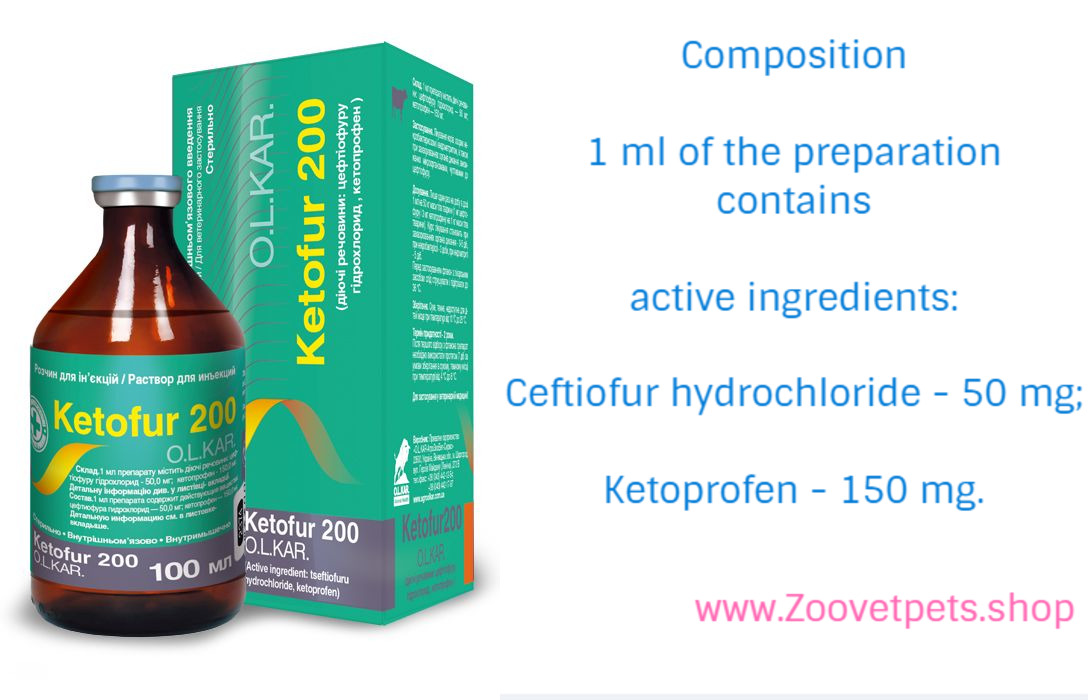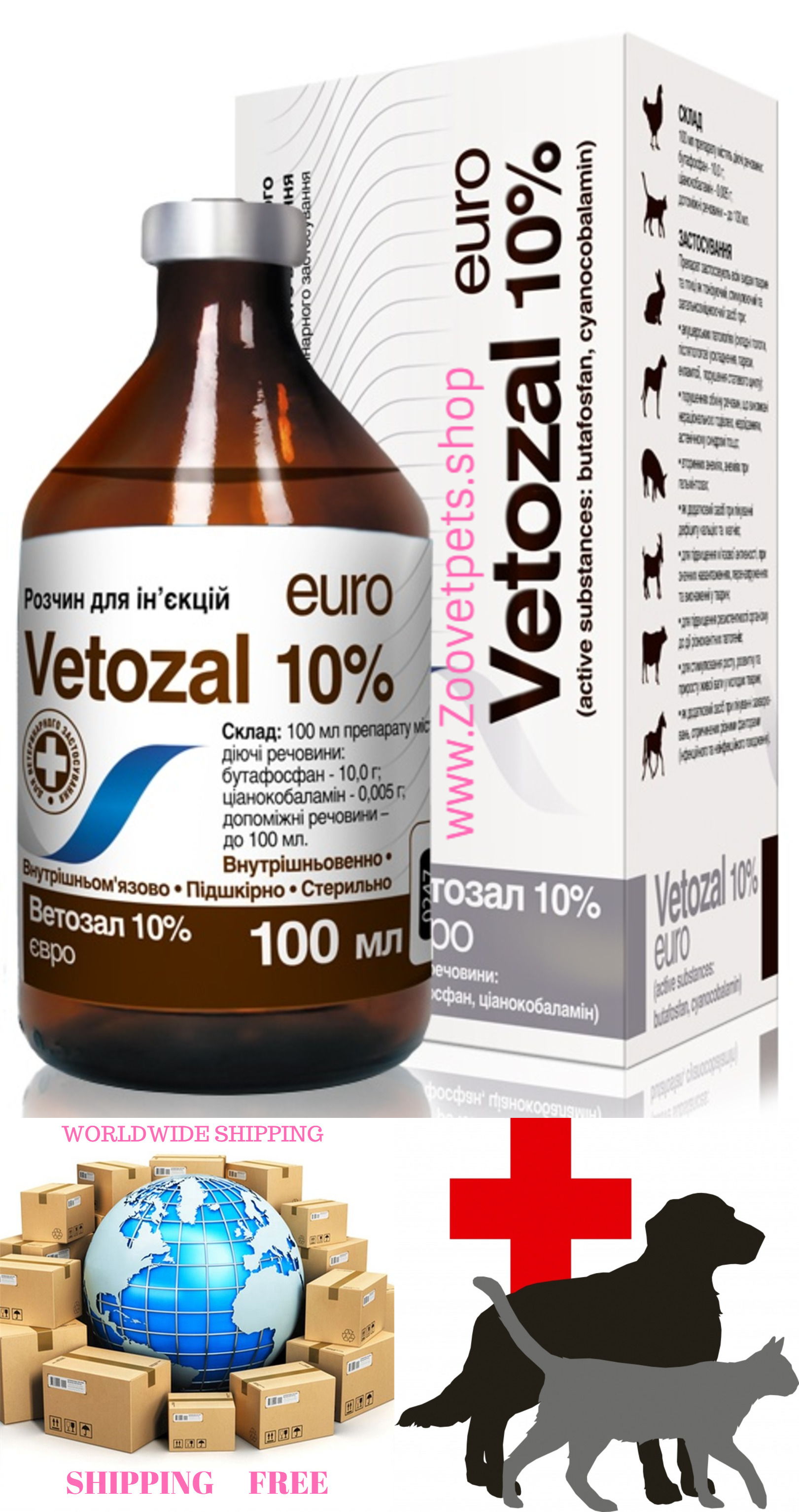Description
Description:
Oily suspension from yellow to brown-yellow, with a slight smell of ingredients, when stored stratified.
Composition:
1 ml of the preparation contains
active ingredients:
Ceftiofur hydrochloride – 50 mg;
Ketoprofen – 150 mg.
Pharmacological properties:
ATC vet classification code QJ01 is an antibacterial veterinary medicine for systemic use. QJ0DDD99 – ceftiofur, combinations.
Ceftiofur belongs to the group of cephalosporins of the third generation. It is active against Gram-positive and Gram-negative bacteria, including strains producing beta-lactamase and some anaerobic bacteria: Escherichia coli, Pasteurella haemolytica, Pasteurella multocida, Haemophilus somnus, Actinobacillus pleuropneumoniae, Haemophilus parasuis, Salmonella cholerasuis, Streptococcus suis, Streptococcus zooepidemicus, Pasteurella spp, Staphylococcus spp.Actynomyces pyogenes, Salmonella typhimurium, Streptococcus agalactiae, S. dysgalactiae, S. bovis, Klebsiella spp., Citrobacter spp., Enterobacter spp., Bacillus spp., Proteus spp., Fusobacterium necrophorum and Porphiromonas assacharolytica (Bacteroides melaninogenicus).ketoprofen – 150 mg.
Pharmacological properties:
ATC vet classification code QJ01 is an antibacterial veterinary medicine for systemic use. QJ0DDD99 – ceftiofur, combinations.
Ceftiofur belongs to the group of cephalosporins of the third generation. It is active against Gram-positive and Gram-negative bacteria, including strains producing beta-lactamase and some anaerobic bacteria: Escherichia coli, Pasteurella haemolytica, Pasteurella multocida, Haemophilus somnus, Actinobacillus pleuropneumoniae, Haemophilus parasuis, Salmonella cholerasuis, Streptococcus suis, Streptococcus zooepidemicus, Pasteurella spp, Staphylococcus spp.Actynomyces pyogenes, Salmonella typhimurium, Streptococcus agalactiae, S. dysgalactiae, S. bovis, Klebsiella spp., Citrobacter spp., Enterobacter spp., Bacillus spp., Proteus spp., Fusobacterium necrophorum and Porphiromonas assacharolytica (Bacteroides melaninogenicus). The mechanism of action of the antibiotic is to suppress the synthesis of the bacterial cell wall.
Ketoprofen is a propionic acid-based NSAID. It has analgesic, anti-inflammatory and antipyretic effects. The mechanism of action is associated with inhibition of prostaglandin synthesis at the level of cyclooxygenase. In addition, ketoprofen inhibits lipoxygenase, has antibradykinin activity, stabilizes lysosomal membranes, and causes significant inhibition of neutrophils. Ketoprofen is a double inhibitor of inflammation, blocking the pathways of action of cycloxygenase and lipoxygenase, and thus preventing the formation of prostaglandins and leukotriens.
Ketoprofen – a disease-disease remedy, affects the central and peripheral nervous system. Its action consists in direct suppression of bradykinin, vasodilators and pain mediator.
After parenteral administration of ceftiofur, the injection points are quickly absorbed and penetrates into all tissues of the animal. Its maximum concentration in plasma is observed after an hour, which is kept at the therapeutic level for up to 24 hours, depending on the type of animals. Ceftiofur in the body is rapidly metabolized to form desfuroiltseftiofur, which has an activity equivalent to ceftiofur in bacteria. This active metabolite binds back to the plasma proteins and accumulates in the infection site, while its activity is not reduced in the presence of necrotic tissues.
Removal of the antibiotic occurs mainly with urine and faeces.
Ketoprofen is quickly absorbed. More than 98% binds to plasma proteins and accumulates in inflamed tissues. Cows have peak plasma levels (8.025 ± 1.9 µg/ml) in less than one hour after insertion. Significant ketoprofen concentrations have been found in synovial fluid and are higher here than in plasma, and the half-life of ketoprofen is 2-3 times higher than in plasma. Ketoprofen is metabolized in the liver to insignificant biologically active metabolites, and 90% is excreted with urine in the form of glucuronide compounds.
Application:
Treatment of cows suffering from necrobacteriosis and endometritis, as well as respiratory diseases caused by microorganisms sensitive to ceftiofuru.
Dosage:
Once a day in a dose of 1 ml per 110 lb (50 kg) of animal body weight (1 mg of ceftiofur and 3 mg of ketoprofen per 2.2lb (1 kg) of animal body weight).
The course of treatment is 3-5 days for respiratory diseases, 3 days for necrobacteriosis and 5 days for endometritis.
Before using the bottle of the drug should be shaken and heated to 97F (36 ° C).
Contraindications:
Do not use animals with hypersensitivity to active substances or any auxiliary substance.
Do not use animals with severe impairment of kidney and liver function.
Do not use animals under the age of 6 weeks.
Do not use animals with hematopoiesis, gastrointestinal ulcers, kidney and liver diseases. Do not use animals in a state of hypotension, hypovolemia and dehydration.
Do not use simultaneously with other non-steroidal anti-inflammatory, diuretic or anticoagulants, as well as tetracyclines, chloramphenicol, macrolides and lyncosamides.
Caution:
Killing animals for meat is allowed 8 days after the last use of the drug. The withdrawal period for milk is 0 hours. The meat is disposed of or fed to unproductive animals by the specified time, depending on the opinion of the veterinary surgeon.
Storage:
Dry, dark, inaccessible for children at temperatures ranging from 50-77F (10 ° C to 25 ° C).
Shelf life – 2 years.
After the first selection from the bottle, the product should be used for 7 days, provided it is stored
in a dry, dark place at a temperature of 40-45F (4 ° C to 8 ° C).







Reviews
There are no reviews yet.